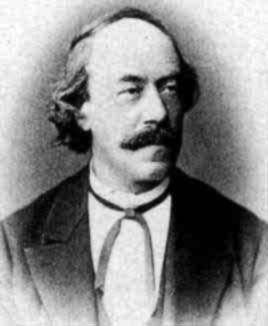
Rudolf Otto Sigismund Lipschitz
 المؤلف:
B Schoeneberg
المؤلف:
B Schoeneberg
 المصدر:
Biography in Dictionary of Scientific Biography
المصدر:
Biography in Dictionary of Scientific Biography
 الجزء والصفحة:
...
الجزء والصفحة:
...
 22-12-2016
22-12-2016
 1082
1082
Born: 14 May 1832 in Königsberg, Germany (now Kaliningrad, Russia)
Died: 7 October 1903 in Bonn, Germany

Rudolf Lipschitz's father was a landowner and Rudolf was born his father's estate at Bönkein which was near Königsberg. He began his university studies at a young age, entering the University of Königsberg and studying there under Franz Neumann. Following the custom of that time to study at different universities, Lipschitz went from Königsberg to Berlin where he studied under Dirichlet. This was not a particularly easy time for Lipschitz whose health was rather poor and caused him to take a year away from his studies to recover. However, he completed his doctoral studies with the award of a doctorate on 9 August 1853.
There was no immediate university teaching post for Lipschitz who spent four years teaching at the Gymnasium in Königsberg and at the Gymnasium in Elbing. In 1857, however, Lipschitz became a Privatdozent at the University of Berlin. In this same year he married Ida Pascha, the daughter of one of the landowners with an estate near to his father's. Then in 1862 he became an extraordinary professor at Breslau.
During his two years in Breslau, Lipschitz wrote two not very important papers. Jointly with Heinrich Schröter and M Frankenheim, he founded a seminar in mathematics and mathematical physics. The paper [5] looks at Lipschitz's career during these two years. He was nominated an ordinary professor by the University of Bonn and he left Breslau at Easter 1864.
The University of Bonn was where Lipschitz spent the rest of his career. This was not because he did not have the opportunity to move. Quite the reverse, after Clebsch died in November 1872 he was offered his chair at Göttingen in the following year. Lipschitz was quite happy at Bonn, however, and he turned down the offer from Göttingen.
Klein received his doctorate from the University of Bonn in 1868. He was supervised by Plücker, and examined by Lipschitz. Perhaps if Klein had still been in Göttingen when Lipschitz was offered the chair there, he may have been more inclined to accept.
Perhaps the most remarkable fact about Lipschitz's work was the widely different topics on which he contributed [1]:-
He carried out many important and fruitful investigations in number theory, in the theory of Bessel functions and of Fourier series, in ordinary and partial differential equations, and in analytical mechanics and potential theory.
He worked on quadratic differential forms and mechanics. In the paper [4] the author shows convincingly how Lipschitz mechanical interpretation of Riemann's differential geometry would prove to be a vital step in the road towards Einstein's special theory of relativity. Lipschitz showed that [4]:-
... the geometrical statements could be interpreted as mechanical laws [but these were] the very mechanical concepts that made it possible to deepen the corresponding geometrical relations.
Lipschitz's work on the Hamilton-Jacobi method for integrating the equations of motion of a general dynamical system led to important applications in celestial mechanics.
Lipschitz is remembered for the 'Lipschitz condition', an inequality that guarantees a unique solution to the differential equation y' = f (x, y). Peano gave an existence theorem for this differential equation, giving conditions which guarantee at least one solution.
His work in algebraic number theory led him to study the quaternions and generalisations such as Clifford algebras. In fact Lipschitz rediscovered Clifford algebras and was the first to apply them to represent rotations of Euclidean spaces, thus introducing the spin groups Spin(n).
- B Schoeneberg, Biography in Dictionary of Scientific Biography (New York 1970-1990).
http://www.encyclopedia.com/doc/1G2-2830902635.html
Articles:
- H Kortum, Rudolf Lipschitz, Jahresberichte der Deutschen Mathematiker-Vereinigung 15 (1906), 56-59.
- W Scharlau, The mathematical correspondence of Rudolf Lipschitz, Historia Math. 13 (2) (1986), 165-167.
- R Tazzioli, Rudolf Lipschitz's work on differential geometry and mechanics, in The history of modern mathematics III (Boston, MA, 1994), 113-138.
- T Weber, Rudolf Lipschitz as professor at Breslau University in the years 1862-1864 (Polish), Wiadom. Mat. 28 (2) (1990), 204-208.
- A P Yushkevich, Sur les origines de la 'méthode de Cauchy-Lipschitz' dans la théorie des équations différentielles ordinaires, Rev. Histoire Sci. Appl. 34 (3-4) (1981), 209-215.
 الاكثر قراءة في 1830to1839
الاكثر قراءة في 1830to1839
 اخر الاخبار
اخر الاخبار
اخبار العتبة العباسية المقدسة


